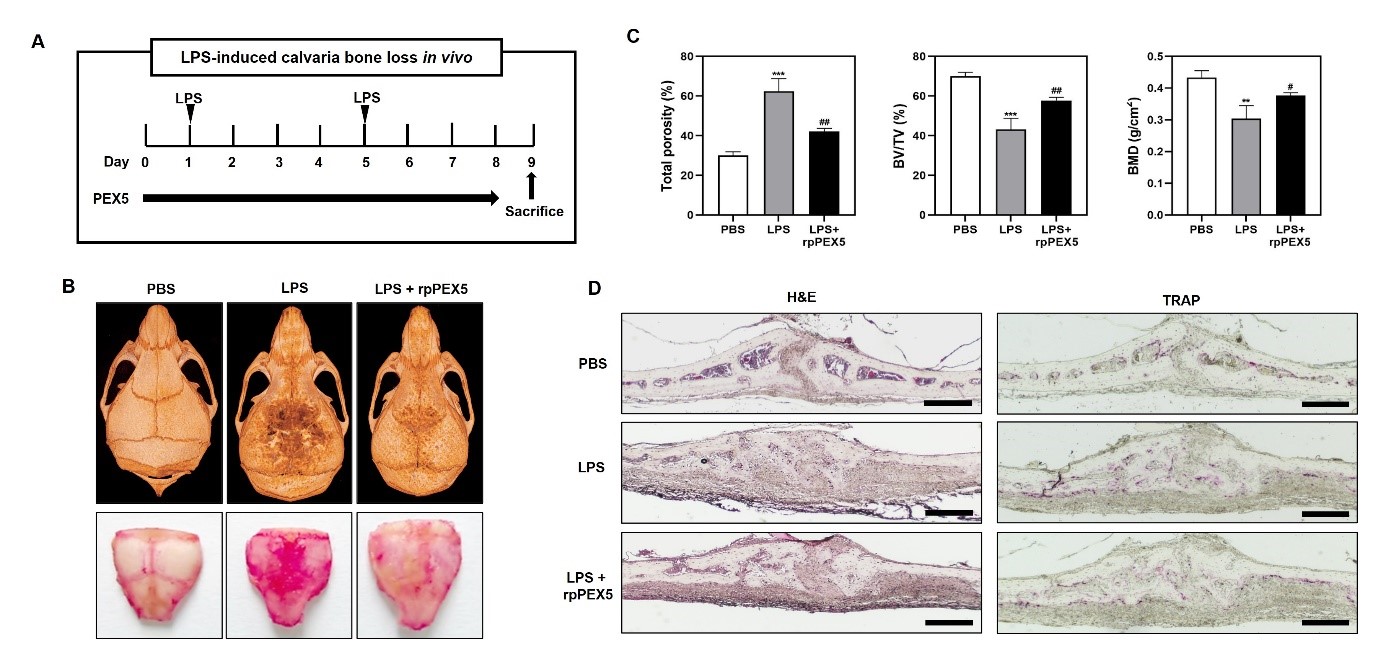Session Information
Date: Monday, November 18, 2024
Title: Osteoporosis & Metabolic Bone Disease – Basic & Clinical Science Poster
Session Type: Poster Session C
Session Time: 10:30AM-12:30PM
Background/Purpose: Peroxisomal biogenesis factor 5 (PEX5) is essential for regulating peroxisome function by recognizing and transporting peroxisome target sequence receptor substrate proteins to peroxisomes. PEX5 defects impair peroxisomal matrix protein uptake, resulting in excessive reactive oxygen species production and delayed bone formation. However, the effects and mechanism of action of PEX5 in regulating bone metabolism via osteoclastogenesis are unknown.We attempted to determine the effects and mechanism of action of PEX5 in regulating bone metabolism via osteoclastogenesis.
Methods: To determine the effect of PEX5 on RANKL-induced osteoclast differentiation and function, we performed TRAP staining, F-actin stating, and bone resorbing assay using PEX5 recombinant protein or siRNA. The intracellular mechanisms responsible for the regulation of osteoclastogenesis of PEX5 were revealed by western blotting and quantitative real-time RT-PCR. Moreover, in vivo test performed in lipopolysaccharide-induced bone loss model and calvarial bone formation model.
Results: By performing gain- and loss-of-function studies, we discovered that PEX5 plays a negative role as a receptor activator of nuclear factor kappa B ligand (RANKL)-induced osteoclastogenesis and bone resorption. During osteoclastogenesis, the knockdown of PEX5 promotes phosphorylation of early signal transducers such as Akt, mitogen activated protein kinase (p38, c-Jun N-terminal kinase, and extracellular signal-regulated kinase), and Bruton’s tyrosin kinase-Phospholipase C gamma2 signaling, resulting in increased mRNA and protein levels of c-Fos and nuclear factor of activated T cells c1. PEX5 depletion strongly induced the expression of osteoclast-specific genes such as OC-stamp, DC-stamp, β3-integrin, osteoclast-associated receptor, ATP6v0d2, and Cathepsin K. Additionally, in vivo, PEX5 reduced lipopolysaccharide-inoculated osteoclastogenesis and bone resorption in mouse calvaria.
Conclusion: We have discovered a novel link between bone-dissolving osteoclasts and PEX5, a critical peroxisome formation regulator. These findings highlight the significance of PEX5 in the regulation of osteoclast formation and suggest that targeting PEX5 could be an effective therapeutic approach for managing bone-related conditions such as osteoporosis.
To cite this abstract in AMA style:
CHUNG C, Lee M, Lee C, Kim J, Cheon Y, Eun S, Park G. PEX5 Acts as a Negative Regulator of RANKL-induced Osteoclastogenesis In Vitro and Inflammatory Calvarial Bone Destruction In Vivo [abstract]. Arthritis Rheumatol. 2024; 76 (suppl 9). https://acrabstracts.org/abstract/pex5-acts-as-a-negative-regulator-of-rankl-induced-osteoclastogenesis-in-vitro-and-inflammatory-calvarial-bone-destruction-in-vivo/. Accessed .« Back to ACR Convergence 2024
ACR Meeting Abstracts - https://acrabstracts.org/abstract/pex5-acts-as-a-negative-regulator-of-rankl-induced-osteoclastogenesis-in-vitro-and-inflammatory-calvarial-bone-destruction-in-vivo/

